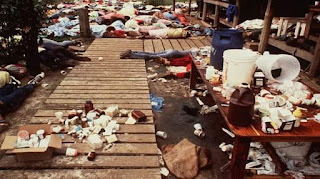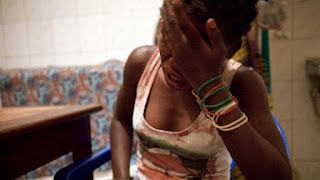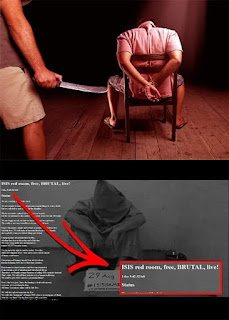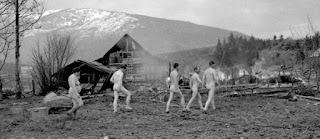THE MASS SUICIDE OF JONESTOWN
THE MASS SUICIDE OF JONESTOWN ON NOVEMBER 18, 1978.
On November 18, 1978, 913 people died in an agricultural colony near the village of Port Kaiutuma, including men, women, the elderly and children. They were all part of the "Temple of Peoples", a cult that had developed around the American preacher Jim Jones.
What happened that afternoon is still considered today as the biggest mass suicide in history.
James Warren Jones was born on May 13, 1931 in the small town of Crete, Indiana. His father was a WWI veteran, his mother a union worker, both parents were not believers, but Jim equally soon became a member of the Pentecostal community. He was attracted to the very "physical" and concrete way of worship of the Pentecostals. At just 16, he preached the gospel of equality before God in the black suburbs of Richmond, Indiana, where he moved with his mother after the separation of his parents.
At the end of the 1940s, racial segregation was very close, and it was estimated that about half of the adult male population in the city had belonged to the Ku Klux Klan for a certain period of time.
Jim Jones' sermons were primarily about racial integration and social justice. He often said:
"THE TIME IN WHICH THERE IS MORE RACIAL SEGREGATION, IN AMERICA, IS THE TIME OF PRAYER OF SUNDAY MORNING"
After the services he accompanied the black members of his congregation in person to the churches of the white suburbs, where they tried to attend the services despite an invariably hostile reception. Together with his wife Marceline, he adopted many children, including African Americans or of oriental origin. His battles and the success of his congregation made him so well known in Indianapolis that in 1961 Mayor Charles Boswell appointed him to head the Human Rights Commission.
When Jones returned to Indiana, he predicted that the Soviet Union would launch nuclear warhead missiles on the United States on July 16, 1967 and invited members of his congregation to move to northern California.
In the early summer of 1965, dozens of families decided to follow Jones on a journey of hundreds of kilometers to Ukiah, California.
"The Bible kills", these were often his words, argued that adherence too faithful to the text was dangerous. He also wrote a book, where he called himself the Messiah of Christianity, and during his sermons he came to throw copies of the holy book on the ground and trample them.
After a few years in the Guyana jungle, his faithful had been firmly convinced, for years of sermons, that the Bible had been written by whites to justify the slavery and oppression of blacks. Jones' religious communities remained actively engaged in helping the marginalized and needy in San Francisco and Los Angeles, to whom they offered medical care, food, legal aid and detoxification pathways.
In 1974 Jones began work on the new project for an agricultural community in Guyana, a country in northeastern South America. He sent some faithful to the country, on land purchased by him, to start working on the plot in the heart of the jungle. After several months of hard work to free the soil from the tropical jungle, the community was a collection of shacks and fields cut out in the middle of the dense equatorial forest, a few kilometers from the small village of Port Kaituma; but the reports that arrived in the United States to the rest of the community of the faithful, carefully suggested by Jones, spoke of a wonderful place, in whose perfect climate women gave birth without pain.
In the midst of his tirades against the real or presumed enemies of the community, often long, inconsistent and violent (Jones had been using vulgar and obscene words for years even during sermons from the pulpit) the preacher spoke of the need for the faithful to begin to "program" the their death. He said that such an important event had to be planned perfectly and that nothing should be left to chance. In a speech of December 21, 1977 he said that all this must be done: "for the victory of the people, for socialism, for communism, for the liberation of blacks, for the liberation of the oppressed"
In Jonestown, Jones summoned all the inhabitants of the colony over the speakers. When everyone was under the pavilion, he announced that the time had come to commit "revolutionary suicide". Jones' speech was long, over three quarters of an hour.
Jones often recorded his sermons, and he did it that time too, it was he himself who operated the tape recorder and stopped recording so as not to record things he didn't want to be recorded. The speech begins in the past: "How very much I’ve loved."
He had a large bin brought and put it on a table in front of the pavilion. Inside the container there was a dark red liquid, it was a mixture of fruit juice, potassium cyanide, Valium, chloral hydrate (an anesthetic) and potassium chloride. Paper cups and packages of syringes were brought. They all lined up in front of the table. Jones had ordered to start giving the drink to the children.
After drinking, people sat quietly in the fields near the pavilion, many of them in tears. Some people resisted, some babies began to cry desperately. Jones and others took the stage and, as the poisoning continued, said that dying was like "a little rest" and reassured those present about the best life that awaited them.











Comments
Post a Comment